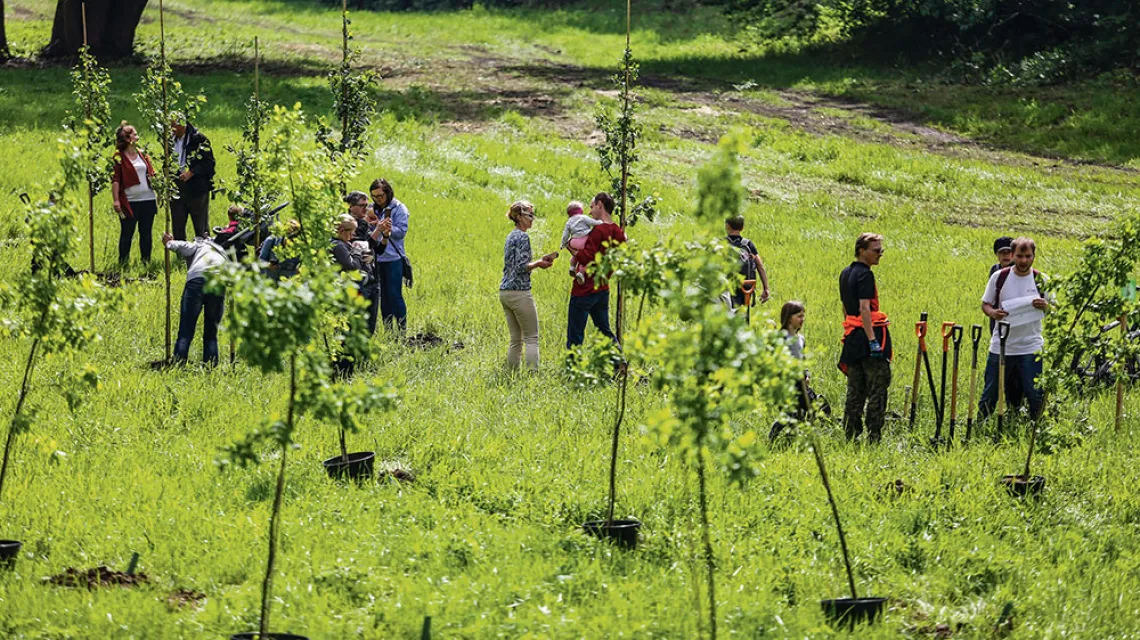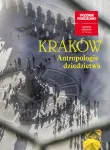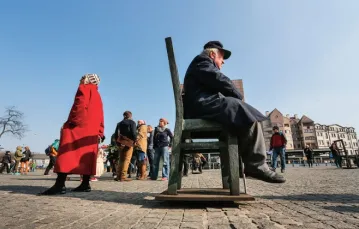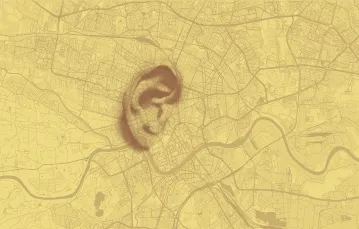Wykupienie dostępu pozwoli Ci czytać artykuły wysokiej jakości i wspierać niezależne dziennikarstwo w wymagających dla wydawców czasach. Rośnij z nami! Pełna oferta →
Although we still have a long way to go before the green ideal is fully achieved, today, in 2050, we can safely say that the right decisions made in the 2020s and 2030s have allowed Kraków to become the greenest city in Poland. In the process, we have also managed to respond to the second big challenge facing the city: the increasing number of older residents.
In 2020, we knew exactly what needed to be done to prepare for a not-so-bright future. In Kraków, as in other Polish cities, two parallel but independent processes, both very dangerous – global warming and population ageing – had already taken hold by that time. Central and local government was slow to act. On the one hand, more and more money was being spent on green space, but on the other, endless stretches of new asphalt were being laid – car travel was still promoted, defying both the scientific consensus and common sense.
June 2019 turned out to be the hottest on record, but every year after 2023 the June temperatures managed to break the previous record – until 2048. Also in 2019, Poland experienced major shortages in power generation capacity, which were so severe that, for a few days, the country had to buy 10% of its electricity from its neighbours. Kraków managed to avoid the problem at that time – news about the temporary difficulties was reported in the media but was quickly forgotten. In the capital of the Małopolska region, the issue returned with a vengeance in 2024, when for an entire month half of all schools were barely able to function and were forced to have their brand new air conditioners switched on the whole time. These machines, despite being energy efficient, consumed so much power that during one week residents only had electricity for 6 hours a day. And their electricity bills were already three times higher than in 2010.
The purchase of air conditioners for schools, which was financed under a multiannual project involving the city, the Małopolska province and school boards, was the last major attempt of the municipal authorities to respond to the effects of rising temperatures rather than to eliminate their causes. The power cuts in 2024, the thunderstorms that caused flooding on an unprecedented scale (some streets in the Zabłocie district were flooded up to knee level for eight days during the year), the spring flood of 2025 (which washed away the Dębnicki Bridge), and finally the appearance of the tiger mosquito – all this finally resulted in a momentum for truly big changes. Greenery was already an important part of those changes at the time, and since the mid-2020s it has been their key element.
The breakthrough was the collapse of the Dębnicki Bridge in 2025, which unexpectedly precipitated a radical change in the way the Aleje Trzech Wieszczów, Kraków’s main arterial road, operates. Once the bridge had disappeared, the road suddenly lost its value as a transit route. For two years, the traffic jams were horrendous, but when in 2027 the city was on the point of rebuilding the road bridge, people protested violently. It was hard to believe that scarcely a decade earlier, in 2017, the public had been equally vociferous in opposing minor changes to Kalwaryjska Street, which were introduced to help the trams run faster.
In 2027, however, the climate was completely different, literally and metaphorically. It took just one car-free summer on Aleje Trzech Wieszczów to make local residents – delighted with the new leisure opportunities that the closure of the road had brought – reluctant to let the cars back in. And there was nothing exceptional about it. Times Square in New York has been free of cars since 2009. The trees planted by Kraków’s Municipal Greenery Board in the vicinity of the Kijów cinema, the former Cracovia hotel, the National Museum, and the Jubilat department store played a key role in this change.
As a result of the protests, the city authorities had to abandon their plans; instead, a wide bridge was built with tram tracks and a lane for trolleybuses down the middle. It also sported broad pavements and lanes for small electric vehicles, especially the increasingly common electric wheelchair. On the Aleje Trzech Wieszczów itself, some of the trees were replanted closer to the house façades, while diseased trees were cut down and replaced with new ones. In the middle of the road, tram tracks and trolleybus lanes were laid. From the Nowy Kleparz market to the Mateczny Roundabout, the city gained a green river of trees surrounded by fabulous modernist and contemporary architecture. On the stretch between the Grunwaldzkie Roundabout and the Forum Hotel, plane trees were planted – as species well suited to Poland’s 2050 climate. The flyover on the Mateczny Roundabout, whose construction had begun in 2023, was rebuilt according to a design by Robert Konieczny, a recent winner of the Mies van der Rohe Prize, Europe’s most prestigious architecture award. Transformed into a tropical park elevated above street level and covered with a giant white tent, the structure became one of the city’s architectural landmarks.
Encouraged by the successful makeover of Aleje Trzech Wieszczów, the Municipal Greenery Board entered the 2030s with new impetus. At that time, the science was already unequivocal – the beneficial impact of trees on global warming was greater than had been thought just two decades earlier. However, the decision to gradually narrow all Kraków’s arterial roads to just one lane in each direction, with pavements for pedestrians, tram lines, and lanes for bicycles and small electric vehicles, was met with long and angry protests from residents who were used to the dominance of car traffic.
After Aleje Trzech Wieszczów, the second major breakthrough was the planting of trees along the Opolska-Lublańska-Bora-Komorowskiego arterial road. The widest street in Kraków suddenly became a single carriageway with perfectly designed solutions for electric wheelchairs and bicycles. When combined with the nearby park and the land around the former airfield, this huge reclaimed area was turned into one of Kraków’s most popular leisure spots without losing any of its transport functions. Despite its owners’ fears, the Serenada shopping mall, which was now surrounded by vegetation as dense as in the jungle, increased its turnover by 15%.
From 2025 to 2045, this gigantic space, stripped of its asphalt, was gradually covered with trees, flower meadows and also some prototype solutions resulting from the marriage of biotechnology and genetics. The vertical walls of grass and flowers erected at that time absorb much more carbon dioxide and have made it possible to prevent the extinction of bees.
The paradigm shift in thinking about green space, transport, and new projects in the city heralded a revolution whose scale rivalled the industrial revolution of the 19th century. Already by 2035, the percentage of journeys made by EPTDs (electric personal transportation devices) rose to 15%, bicycles added another 15%, and public transport was used for half of all journeys around the agglomeration. Cars accounted for less than 20% of journeys. The green corridors on Dietla, Powstania Warszawskiego, aleja Pokoju, Wielicka, Opolska, and Bora-Komorowskiego changed the way people think about mobility. On single carriageways, traffic jams only occurred on Friday afternoons and when the weather was particularly bad.
Such a radical change would not have been possible without the cooperation of many institutions, and Polish State Railways were an important contributor. The success of the railway station near the Hala Targowa covered market, which became functional in 2021, and the growing need for rail transport within the Kraków agglomeration triggered a wave of spectacular rail investment projects in the Małopolska region. By 2040, the number of dangerous minibuses plying the region’s roads had decreased by 80%.
The green revolution of the 2020s and 2030s changed the perspective on the earlier measures introduced in 2015–2020. The impressive projects undertaken by the Municipal Greenery Board at that time turned out to be just a small, although obviously important, prelude to what was to come later.
The added value of the green revolution was that it made life much easier for a large group of Kraków residents – senior citizens. In 2040 the median age was 50, and in 2050 it is already 53. This means that more than half the population of the Kraków agglomeration is older than 50. For this group, a city full of greenery, in which roads are literally hidden in tunnels of vegetation, translates into much better health and well-being and also facilitates mobility. Symbolically, on the 25th anniversary of the city’s greening campaign, an application was submitted to the Ministry of Health for the district of Nowa Huta to be recognised as a health resort. It was only red tape which prevented the district, once famous for its huge iron and steel works, from adding the word “Zdrój” (spa) to its name on the occasion of its 100th birthday in 2049. Instead, Nowa Huta-Zdrój will most probably appear on maps of Poland in 2052. ©
PIOTR KOZANECKI is head of the Onet.pl News Department and co-author of the Teren Zabudowany (built-up area) blog.
KRAKÓW. ANTROPOLOGIE DZIEDZICTWA – CZYTAJ CAŁY DODATEK SPECJALNY >>>
KRAKOW. ANTHROPOLOGIES OF HERITAGE – READ MORE IN ENGLISH >>>










